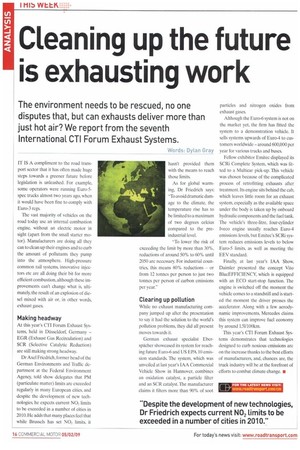Cleaning up the future is exhausting work
Page 16

If you've noticed an error in this article please click here to report it so we can fix it.
The environment needs to be rescued, no one disputes that, but can exhausts deliver more than just hot air? We report from the seventh International. CTI Forum Exhaust Systems.
Words: Dylan Gray
IT IS A compliment to the road transport sector that it has often made huge steps towards a greener future before legislation is unleashed. For example, some operators were running Euro-5spec trucks almost two years ago, when it would have been fine to comply with Eum-3 regs.
The vast majority of vehicles on the road today use an internal combustion engine, without an electric motor in sight (apart from the small starter motor). Manufacturers are doing all they can to clean up their engines and to curb the amount of pollutants they pump into the atmosphere. High-pressure common rail systems, innovative injectors etc are all doing their bit for more efficient combustion, although these improvements can't change what is, ultimately, the result of an explosion of diesel mixed with air or, in other words, exhaust gases.
Making headway
At this year's Cl! Forum Exhaust Systems, held in Diisseldorf, Germany — EGR (Exhaust Gas Recirculation) and SCR (Selective Catalytic Reduction) are still making strong headway.
Dr Axel Friedrich, former head of the German Environments and Traffic department at the Federal Environment Agency, told show delegates that PM (particulate matter) limits are exceeded regularly in many European cities, and despite the development of new technologies. he expects current NO2 limits to be exceeded in a number of cities in 2010. He adds that many places feel that while Brussels has set NO2 limits. it hasn't provided them with the means to reach those limits.
As for global warming, Dr Friedrich says: -To avoid dramatic damage to the climate, the temperature rise has to be limited to a maximum of two degrees celcius compared to the preindustrial level.
"To lower the risk of exceeding the limit by more than 30%, reductions of around 50% to 60% until 2050 are necessary. For industrial countries, this means 80% reductions — or from 12 tonnes per person to just two tonnes per person of carbon emissions per year."
Clearing up pollution
While no exhaust manufacturing company jumped up after the presentation to say it had the solution to the world's pollution problems, they did all present moves towards it.
German exhaust specialist Eberspacher showcased its system for reaching future Euro-6 and US EPA 10 emission standards. The system, which was unveiled at last year's IAA Commercial Vehicle Show in Hannover, combines an oxidation catalyst, a particle filter and an SCR catalyst. The manufacturer claims it filters more than 90% of soot particles and nitrogen oxides from exhaust gases.
Although the Euro-6 system is not on the market yet, the firm has fitted the system to a demonstration vehicle. It sells systems upwards of Euro-4 to customers worldwide — around 600,000 per year for various trucks and buses.
Fellow exhibitor Emitec displayed its SCRi Complete System, which was fitted to a Multicar pick-up. This vehicle was chosen because of the complicated process of retrofitting exhausts after treatment. Its engine sits behind the cab, which leaves little room for an exhaust system, especially as the available space under the body is taken up by onboard hydraulic components and the fuel tank. The vehicle's three-litre, four-cylinder Iveco engine usually reaches Euro-4 emissions levels. but Emitec's SCRi system reduces emissions levels to below Euro-5 limits, as well as meeting the EEV standard.
Finally, at last year's IAA Show, Daimler presented the concept Vito BlueEFFICIENCY, which is equipped with an ECO start-stop function. The engine is switched off the moment the vehicle comes to a standstill and is started the moment the driver presses the accelerator. Along with a few aerodynamic improvements, Mercedes claims this system can improve fuel economy by around 1.51/100km.
This year's CTI Forum Exhaust Systems demonstrates that technologies designed to curb noxious emissions are on the increase thanks to the best efforts of manufacturers, and, chances are, the truck industry will be at the forefront of efforts to combat climate change. • (j+ FOR THE LATEST NEWS VISIT:
















































































































































